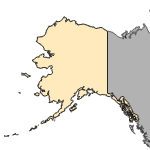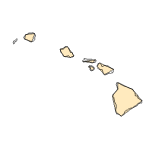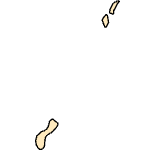Poecilia spp. hybrid
(lyretail black molly)
Fishes
Exotic Hybrid |
|
Common name: lyretail black molly
Native Range:



|

Alaska |

Hawaii |

Puerto Rico &
Virgin Islands |

Guam Saipan |
Hydrologic Unit Codes (HUCs) Explained
Interactive maps: Point Distribution Maps
Nonindigenous Occurrences:
Table 1. States with nonindigenous occurrences, the earliest and latest observations in each state, and the tally and names of HUCs with observations†. Names and dates are hyperlinked to their relevant specimen records. The list of references for all nonindigenous occurrences of Poecilia spp. hybrid are found here.
Table last updated 12/15/2025
† Populations may not be currently present.
Ecology: Similar to parental species (see Remarks).
Means of Introduction: Likely aquarium release or escape from tropical fish farm.
Status: Formerly reproducing, now failed. Not listed by Shafland et al. (2008).
Impact of Introduction: The impacts of this species are currently unknown, as no studies have been done to determine how it has affected ecosystems in the invaded range. The absence of data does not equate to lack of effects. It does, however, mean that research is required to evaluate effects before conclusions can be made.
References: (click for full references)
Courtenay, W.R., Jr., H.F. Sahlman, W.W. Miley, and D.J. Herrema. 1974. Exotic fishes in fresh and brackish waters of Florida. Biological Conservation 6(4):292-302.
Shafland, P.L., K.B. Gestring, and M.S. Stanford. 2008. Florida's exotic freshwater fishes - 2007. Florida Scientist 71(3):220-245.
Other Resources:
Fact Sheet for Poecilia formosa - USGS Nonindigenous Aquatic Species Database
Fact Sheet for Poecilia latipinna - USGS Nonindigenous Aquatic Species Database
Fact Sheet for Poecilia latipunctata - USGS Nonindigenous Aquatic Species Database
Fact Sheet for Poecilia mexicana - USGS Nonindigenous Aquatic Species Database
Fact Sheet for Poecilia petensis - USGS Nonindigenous Aquatic Species Database
Fact Sheet for Poecilia reticulata - USGS Nonindigenous Aquatic Species Database
Fact Sheet for Poecilia sphenops - USGS Nonindigenous Aquatic Species Database
Author:
Matt Neilson, and Bill Loftus
Revision Date: 5/9/2019
Peer Review Date: 9/18/2012
Citation Information:
Matt Neilson, and Bill Loftus, 2025, Poecilia spp. hybrid: U.S. Geological Survey, Nonindigenous Aquatic Species Database, Gainesville, FL, https://nas.er.usgs.gov/queries/FactSheet.aspx?speciesID=854, Revision Date: 5/9/2019, Peer Review Date: 9/18/2012, Access Date: 12/15/2025
This information is preliminary or provisional and is subject to revision. It is being provided to meet the need for timely best science. The information has not received final approval by the U.S. Geological Survey (USGS) and is provided on the condition that neither the USGS nor the U.S. Government shall be held liable for any damages resulting from the authorized or unauthorized use of the information.